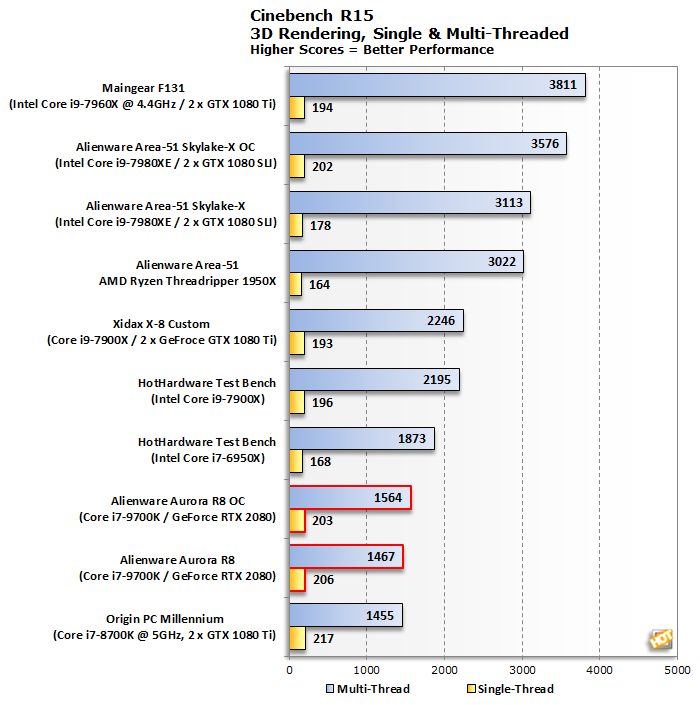Alienware Aurora R8 Review: A Compact RTX Gaming Powerhouse
|
We start things off with the tried and true processor benchmark, Cinebench R15. During our testing, Cinebench R20 was also released to the public, so we have both results for comparison



In these benchmarks, the Aurora R8's Core i7-9700K stares down a number of workstation-grade, many-core behemoths from Threadripper to Skylake-X. While this consumer oriented processor cannot compete on the multi-threaded front, it does put up strong single-threaded numbers, which are important for gaming and general system responsiveness.
|
POV-Ray, or the Persistence of Vision Ray-Tracer, is an open source tool for creating realistically lit images. We tested with POV-Ray's standard 'one-CPU' and 'all-CPU' benchmarking tools on all our test machines and recorded the scores reported for each. Results are measured in pixels-per-second throughput; higher scores equate to better performance.

POV-Ray is another benchmark which benefits heavily from many-core processors. The Aurora R8's middle of the pack multi-threaded performance is respectable when you consider the Core i7-9700K has just 8 cores and 8 threads up against the Core i9-7980XE's 18 cores and 32 threads.
Once again its single-threaded performance is strong in the field, though we find the same single-core performance regression from Cinebench when overclocked. We do not have an explanation for this, per se, but it does not seem to create performance issues elsewhere.
|
PCMark 8 simulates the workloads computers face in several different settings, including home, office and content creation. The benchmark also has a test that simulates a creative professional’s usage, as well as battery and storage tests. We ran the tests with OpenCL acceleration enabled to leverage the power of the system's GPU, CPU and storage subsystem combined.

The Aurora R8's PCMark 8 score reflects a well balanced system. It comfortably outperforms other single GPU systems and is within striking distance of the top performers. Admittedly there can be a bit of variance between PCMark 8 runs, but we can say with confidence that this configuration is a strong performer here.
|
PCMark 10 covers a wide range of activities from everyday productivity tasks to demanding work with digital media content. It is broken down into four subscores. Essentials covers common, everyday workloads including Web browsing, video conferencing, and app launching. Productivity measures system performance with office applications including spreadsheets and document writing. Digital Content Creation reflects digital content and media creation including photo editing and video editing, rendering and visualization. Finally, Gaming tests real-time graphics and physics with two graphics tests, a physics test, and a combined test.







